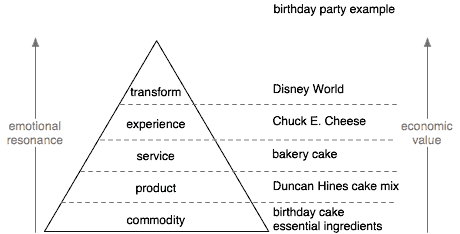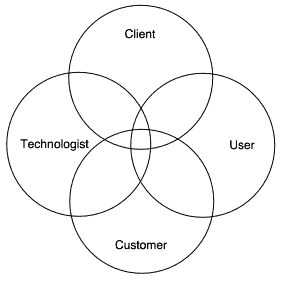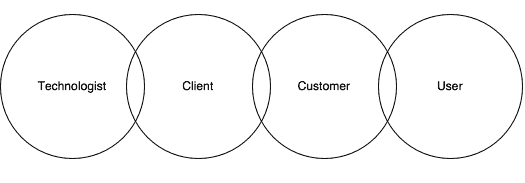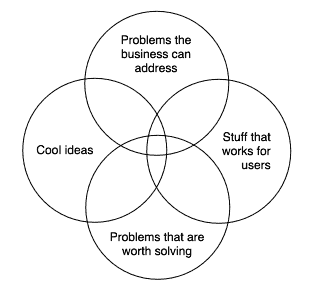October 25, 2003
Urban Bookstore Pligrimages
I realized, on this last trip, that when I travel, I inevitably end up at the certain favorite bookstores.
In Cambridge, I make a point of visiting the MIT Press Book Store, and Wordsworth.
In Chicago, I've got to go to Quimby's. And the Seminary Co-op might prove necessary on future itineraries. (Thanks, Betsy!)
New York City? Gotham Book Mart. (Looks like they might be moving.)
Washington, D.C.? Kramerbooks and Afterwords cafe.
In Portland, well, it's just too obvious.
Huh. The other cities I often return to are Austin and L.A. And while I like The Book People in Austin, it's never been very compelling (unlike, say, sitting outside at Jo's.)
October 23, 2003
HITS Parting Thought: Innovation Fetishization
The HITS 2003 conference was very focused on the idea of innovation. Whenever designers talk about business, they can't get away from the need to "innovate." It seems to be what designers think they can best offer business.
Such an obsession with "innovation" worries me. It worries me because I live in a world where the things that already exist typically don't work as well as they should. More time should be spent bringing existing products and services up to snuff, and not focusing on The Next Big Thing. This innovation fetishization becomes a shiny bauble distracting people from paying attention to the here and now.
I also find that most of us don't get to work on "innovation." We'd love to, but it's not practical. Maybe it's just me, but the bulk of my work is to get corporations to stop fucking up how they do things, or, at least, to fuck up as little as possible. Conferences like HITS make me nervous because I fear that folks (particularly students, who were very much in attendance) think that life is about innovation, and then will be needlessly disappointed when they enter the real world and find out that the bulk of their time is spent shoring up poorly planned solutions.
Not that I'm against innovation. There's a place for innovation. I wish my work afforded me more ability to innovate. But we've got to be careful to not forsake the now in favor of planning for some distant future.
Oh, and most of the presentations from HITS are up. I've gone back to my old posts and updated them with links, where appropraite.
October 22, 2003
Highlights from HITS Part 3: Summary Thoughts
The prior two posts weren't the only things that happened at HITS. Don Norman exhibited remarkable contradiction by railing against BusinessWeek's annual design awards for focusing on the external aesthetics and not about deep use, only to then talk about how an object's beauty can create an emotional resonance that makes the fact that people can't figure out how to use it moot. There were a few case studies of design processes leading to business success, most of which seemed like a way that ID can crow about how its grads are doing great work out in the world. Larry Keeley of the Doblin Group charmed the crowd with his Big Idea talk on innovation[5.1MB PDF], presented like a true showman. (It's also clear Larry is super smart. For those playing along at home, many moons ago I posted about the Doblin Group (scroll down to September 16, 1999))
Overall, I found HITS 2003 a worthwhile experience. (Literally--I think it's the only conference I paid for out of my pocket all year.) There was a curious aspect to it. It's an inaugural conference. I've been to two other inaugural conferences in recent memory (ASIS' IA Summit in 2000, DUX in 2003), and both of those were very much a coming together of a community, bringing into a single place individuals who had felt a little lost or uncertain of their professional stature, making it clear that there is a place for them.
That did not happen with HITS. There is no identifiable "design + business" community. I think because the problem is too big, too diffuse. Design and business intersect at so many points -- how people interact in an organization, the value that design adds to products and services, the use of design methods to inform anything from high-level strategy to specific object, brand, etc. etc. -- that it can never be the nexus of a clearly defined community. I mean, I'm definitely interested in where design and business meet, but I didn't feel like I was among "my people" at HITS. Again, not that I didn't enjoy it -- it's just didn't feel transformative the way those other two events did.
October 21, 2003
Highlights from HITS Part 2: Experience Economics
IDEO's CEO Tim Brown spoke a bit about experience economics. He showed a lot of shiny pictures from their work on the Prada store, but I was more interested in two frameworks he discussed. The first is a pyramid that comes from the book "The Experience Economy" (I don't know if the 'birthday party' example is from there, too, or was Tim's example).

The second interesting idea is that in order for an experience to have an economics, it must fit these three criteria:
- the customer knows they had an experience
- the provider owns that experience
- the customer can tell others about that experience
Later on, in an unrelated panel discussion, ID professor John Heskett mentioned that the key core element that design brings to the business equation is "value creation." Of all the things the businesses desire in their processes, what design can most obviously and directly influence is the creation of "value" to be added to the product or service. I've heard this argument before, usually related to Michael Porter's "value chain."
Highlights from HITS Part 1: MBA 101 and Design
[There will be 3 highlights posts]
Last week I attended the inaugural HITS (Humans Interaction Technology Strategy) conference, sponsored by IIT's Institute of Design. An attempt to bridge the worlds of Design and Business, it offered a lot of food for thought. There was no ability for real-time blogging (the conference took place in a remarkably unwired venue), so here are some notes after the fact.
On the first day, we were treated to a couple of cold water presentations, one by Tom MacTavish from Motorola, and another by Jim Euchner from Pitney Bowes. I call them "cold water" because their diehard business perspective was an awakening splash in the face. Also, both utilized the ugliest PowerPoint templates you'll ever seen in a conference sponsored by a design school.
Tom's talk was a no-nonsense look at understanding business and technology[244k PDF], with clues as to how to get the most out of your organization, and how to read financial statements.
Jim's talk was more about the reorganization of teams in order to better encourage product design that succeeds. Jim had two four-circle Venn diagrams that I liked.
The first diagram was of the human elements that go into product design. Ideally, you have them all converge to produce the best work:

("Technologist" can be thought of as the engineer/designer, client is the internal business owner, customer is the person who buys the technology, and user is the person who will use it. Oftentimes in enterprises, the customer and the user are different people.)
He pointed out, though, that the reality is that the rings don't overlap, but get pulled to form a chain...

The client and customer serve as intermediaries in a chain between the technologist and the user. Such an arrangement hampers success, as it resembles the child's game "Telephone," where the fidelity of the message degrades as it passes from person to person.
I loved the idea of pulling the rings from that idealized Venn diagram to form a truer representation of how these things really work.
Another diagram of his also had four rings:

I liked this because it intelligently extends the more typical Venn diagram of feasibility/viability/desirability. It shows that feasibility has two aspects: 1) What we have the technology to build ("Cool ideas") and 2) What the business is geared to address. It's not enough to simply address a "problem worth solving" -- you also must consider whether your organization has the resources to meaningfully address that problem.
One of the things not mentioned in these first two presentations is ROI. Metrics. Finances. So I raised my hands and asked Tom and Jim about how do we consider the ROI of the design component (as we're increasingly asked to do these days) and both pointed out that the various parts of the process are so tightly integrated that awarding elements of the ROI to any particular contributor is nearly impossible. (I don't know if I agree, but I was intrigued that this was the response.)
In all, I was happy to see elemental business questions being addressed so straightforwardly as a way to lead off the day.
October 19, 2003
Chicago's Hottest Hot Spots!
I've spent the last few days in Chicago. It's 10pm on a Sunday, and I'm currently in a Starbucks on North and Wells -- and it's *packed*. All students. Lotsa laptops. Lotsa highliters. It's crazy busy. It's the first 24-hour Starbucks I've ever seen. Anyway. Carry on.
Novel Science
In my last post, I mentioned Radiant Cool, a novel that also happens to put forth a new theory of consciousness. Today, The New York Times Book Review features it and some other attempts at novel explanations of science.
